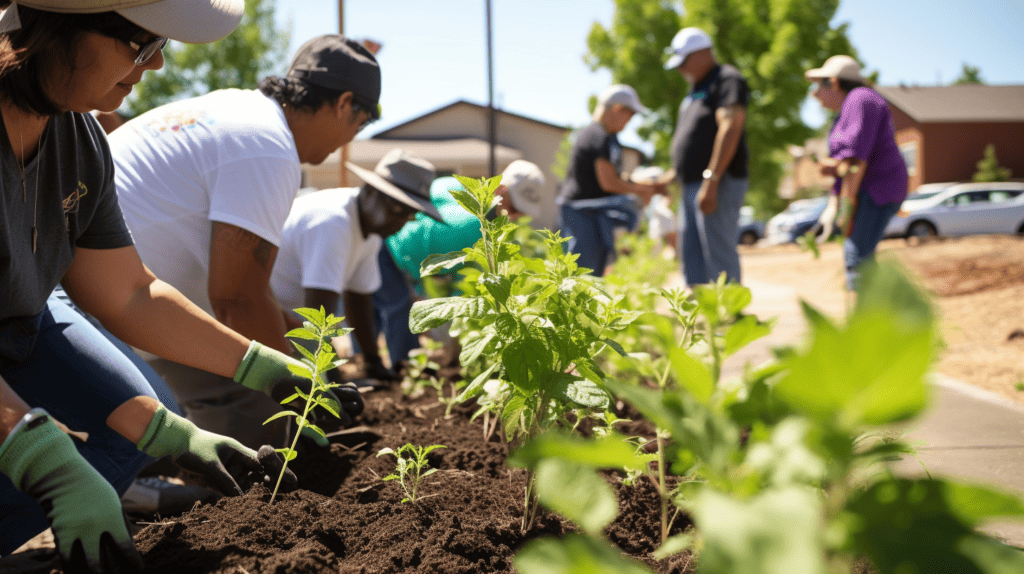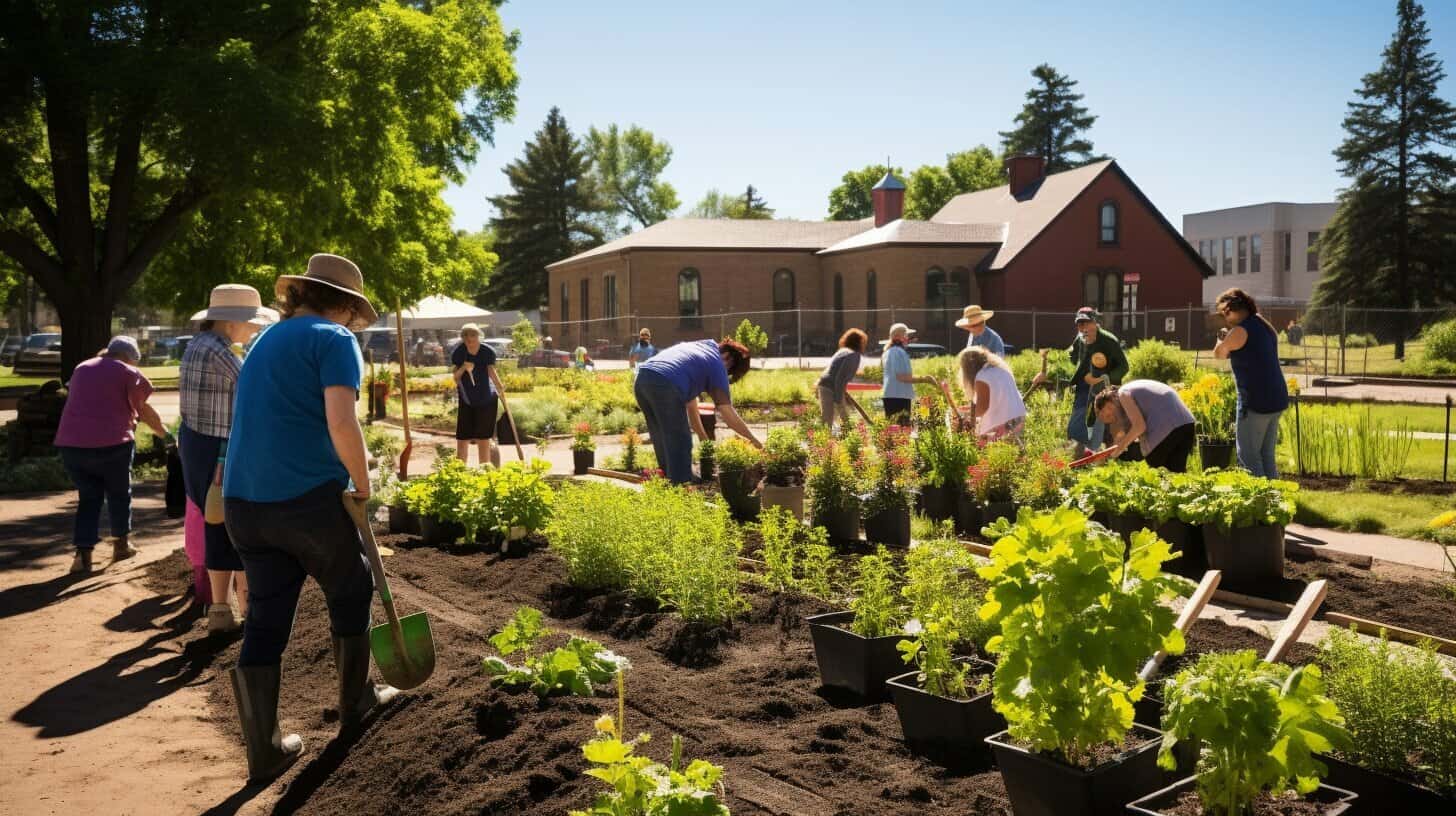Welcome to our guide on giving back in the community and making a positive impact. At its core, community involvement is about social responsibility. Whether you’re volunteering at a local charity, supporting a nonprofit organization, or starting your own charitable initiative, giving back is a powerful way to make a difference in the world around you.
In this guide, we’ll explore some of the many ways you can get involved in your community, from volunteering to philanthropy to starting your own initiatives. We’ll also provide tips on how to make the most of your efforts and maximize the impact of your contributions.
Volunteer Work: Making a Difference in Your Community
Volunteer work is an excellent way to get involved in your community and make a positive impact. There are many different types of volunteer opportunities available, from working at a local food bank to helping with community events.
One of the benefits of volunteering is the opportunity to engage with your community and meet new people who share similar interests. This can lead to greater community engagement and a sense of social responsibility.
| Types of Volunteer Work | Examples |
|---|---|
| Community Service | Working at a local food bank, cleaning up a park, or assisting at a charity event |
| Mentoring/Teaching | Tutoring a child, coaching a sports team, or teaching a class |
| Environmental | Cleaning up a beach, helping with a recycling program, or planting trees |
| Animal Welfare | Volunteering at an animal shelter, fostering animals, or assisting at a wildlife rehabilitation center |
Volunteering doesn’t have to take a lot of time or effort, either. Even just a few hours a week can make a significant difference in your community. Plus, the benefits of giving back can be personally rewarding, too.
Volunteer Work: Making a Difference in Your Community.
If you’re interested in getting involved in volunteer work, start by researching opportunities in your area. You can check with local nonprofits, community centers, or even your city’s website for information on upcoming events and programs. Once you find an opportunity that interests you, reach out and find out how you can get involved.
In addition to traditional volunteer work, there are also many online opportunities available, including virtual tutoring, fundraising efforts, and social media campaigns. You don’t have to physically be in the same location as the organization to make a difference.
Ultimately, volunteering is a great way to make a positive impact on your community and help others, while also gaining valuable experience and skills. So why not give it a try?
Corporate Social Responsibility: Giving Back Through Business
Corporate social responsibility is an increasingly important aspect of modern business. More and more companies are recognizing the importance of giving back to the community and engaging in charitable activities. These initiatives not only make a positive impact on the community, but also benefit the business itself by enhancing its reputation and improving employee morale.
There are many different types of charitable activities that businesses can engage in. Some companies choose to donate a portion of their profits to charitable organizations, while others organize volunteer events or sponsor community initiatives. Whatever the approach, businesses that make a commitment to corporate social responsibility demonstrate their dedication to making a positive impact on the world.
| Examples of Corporate Social Responsibility Initiatives | Benefits for the Community and Business |
|---|---|
| Donating a percentage of profits to a local charity | Directly supports a local cause and enhances the company’s public image |
| Organizing employee volunteer events | Allows employees to give back to the community and fosters a sense of teamwork and community within the company |
| Sponsoring a community event or initiative | Provides financial support for a local cause or event and demonstrates the company’s commitment to the community |
Businesses that prioritize corporate social responsibility not only benefit the community, but also their own bottom line. According to a study by Cone Communications, 87% of consumers are more likely to purchase a product from a company that supports a cause they care about. Additionally, a company with a positive reputation for social responsibility is more attractive to job seekers and may experience higher levels of employee retention.
Successful Examples of Corporate Social Responsibility
One example of a business that has made a significant impact through corporate social responsibility is TOMS, a shoe company that donates a pair of shoes for every pair purchased. Since its founding in 2006, TOMS has given away over 100 million pairs of shoes to people in need around the world.
Another example is Patagonia, an outdoor clothing company that has made environmental sustainability a core focus of its business model. The company has implemented environmentally-friendly practices in its manufacturing and has donated over $100 million to environmental causes through its “1% for the Planet” initiative.
These successful examples demonstrate how businesses can make a positive impact through corporate social responsibility initiatives. By prioritizing social responsibility, businesses can not only improve their reputation and bottom line, but also make a significant difference in their communities.

Community Engagement: Involving Yourself in Local Causes
Supporting local causes is an incredibly valuable way to give back to your community. By getting involved in community service and philanthropy, you can make a positive impact and help support initiatives that matter to you and your neighbors.
There are many ways to get involved in community engagement, from volunteering your time to donating money to charitable organizations. By finding causes that are important to you, you can make a real difference in your community and help create lasting change.
Volunteering Your Time
One of the most direct ways to get involved in community service is through volunteering your time. There are many different types of volunteer work available, from working at a local food bank to helping with a community event or clean-up effort.
By volunteering, you can not only support important initiatives and organizations, but also connect with your community and meet new people who share your passion for making a difference.
Donating To Philanthropic Organizations
If you don’t have the time to volunteer, or simply prefer to contribute in other ways, donating to philanthropic organizations can be a great way to make a difference. There are many different types of charities and nonprofits to choose from, each with their own unique missions and goals.
When considering where to donate your money, it’s important to do your research and choose reputable organizations with a proven track record of success. Look for organizations that are transparent about their operations and financials, and ensure that your donation will be used effectively and efficiently to support their initiatives.
Supporting Local Businesses and Initiatives
Another way to get involved in community engagement is by supporting local businesses and initiatives. By shopping at locally-owned stores or attending community events and fundraisers, you can help support the local economy and contribute to initiatives that matter to your community.
Whether you’re volunteering your time, donating money, or simply showing your support, there are many different ways to get involved in community engagement and make a positive impact in your community. By finding causes that matter to you and working together with others, you can help create lasting change and foster a sense of social responsibility in your community.
Starting Your Own Charitable Initiative: Making a Difference on Your Own Terms
If you want to make a difference in your community but don’t know where to start, consider starting your own charitable initiative. This can be a great way to give back on your own terms and make a direct impact in your community.
Here are some steps to help you get started:
- Identify a need in your community: Take a look around your community and identify a need that you are passionate about. This could be anything from feeding the homeless to supporting local schools.
- Gather a group of like-minded individuals: Reach out to friends, family, and colleagues who share your passion for the cause. Having a team will help you stay motivated and make a bigger impact.
- Develop a plan: Create a plan that outlines your goals, target audience, and budget. This will help you stay organized and focused on your mission.
- Raise funds: You’ll likely need some funds to get your initiative off the ground. Consider organizing a fundraiser, applying for grants, or leveraging social media to raise awareness and donations.
- Execute your plan: Once you have a plan and funding in place, it’s time to put everything into action. Be sure to document your progress and results along the way.
- Celebrate your successes: Take time to celebrate your successes and the impact you have made in your community.
“The best way to find yourself is to lose yourself in the service of others.” – Mahatma Gandhi
Starting your own charitable initiative can be a fulfilling and rewarding experience. Not only will you be making a positive impact in your community, but you’ll also be gaining valuable leadership skills and learning more about yourself in the process.
Impactful Philanthropy: Making the Most of Your Donations
Philanthropy is a way for individuals to make a positive impact on their communities and the world at large. However, it’s important to make informed decisions when it comes to charitable giving in order to maximize the impact of your donations. Here are some tips to help make your philanthropy more impactful:
Do Your Research
Before making a donation, it’s important to research the organization you’re considering supporting. Look for reputable organizations that have a track record of success in making a positive impact in their communities. Charity watchdog websites like Charity Navigator and GuideStar can be helpful resources for evaluating nonprofits.
Consider the Impact of Your Donation
When deciding where to make your donation, consider the potential impact of your gift. Look for organizations that have specific, measurable goals and track their progress towards those goals. This can help ensure that your donation is being used effectively to create real change.
Think Beyond Monetary Donations
While monetary donations are important, there are other ways to support charitable causes. Consider volunteering your time or donating goods and services to organizations in need. This can help maximize your impact while also providing valuable support to organizations.
Collaborate for Greater Impact
Working with others can help maximize the impact of your philanthropic efforts. Consider collaborating with other donors or organizations to create a larger impact. This can include joining a giving circle, partnering with other donors on a specific project, or supporting a community-wide fundraising effort.
By making informed decisions and collaborating with others, you can maximize the impact of your philanthropy and make a real difference in your community and beyond.

Giving Back Through Education: Supporting the Next Generation
One impactful way to give back to the community is through education. By supporting the next generation, we can help ensure a brighter future for our communities. There are many ways to get involved in giving back through education, from volunteering in schools to supporting education-focused charities.
Here are a few ways you can make a difference:
| Volunteer in Schools | If you have expertise in a particular subject, you can volunteer as a tutor or mentor for students in your local schools. Many schools also have volunteer opportunities in areas such as classroom assistance, reading programs, and fundraising events. |
|---|---|
| Support Education Charities | There are many charities that focus on education, such as those that provide school supplies or scholarships for low-income students. Research and donate to reputable organizations to make a real impact. |
| Advocate for Education | Use your voice to support education initiatives in your community, whether it’s by attending school board meetings or advocating for policies that support education equity. Your voice matters! |
Supporting the next generation through education not only benefits individuals, but also the community as a whole. By investing in education, we can help empower future leaders and create a stronger and more prosperous community.
The Role of Nonprofits: Making an Impact Through Advocacy
Nonprofits play a crucial role in making a positive impact in communities around the world. These organizations work tirelessly to provide essential services and support to those in need, from addressing health disparities to promoting social justice. However, their impact extends far beyond direct service provision. Nonprofits also play a critical role in advocacy efforts, working to promote policy changes and create systemic change.
Advocacy can take many forms, from lobbying for legislative change to building public awareness around a particular issue. Nonprofits are often uniquely positioned to engage in advocacy efforts, as they have direct experience working with the communities they serve and can bring their stories and experiences to the forefront of policy discussions.
| Examples of Nonprofit Advocacy Initiatives | Impact on the Community |
|---|---|
| Advocating for policy changes to expand access to healthcare | Improved health outcomes for underserved and marginalized communities |
| Advocating for increased funding for public education | Improved educational opportunities and outcomes for children in low-income communities |
| Advocating for criminal justice reform to address racial disparities | Reduction in racially-biased policing and sentencing practices, improved outcomes for communities of color |
Nonprofit advocacy efforts have the potential to create lasting change, driving systemic changes that can have a profound impact on the communities they serve. By working together and engaging in coordinated advocacy efforts, nonprofits can amplify their impact and create a more just and equitable society.
Advocacy vs. Lobbying: Understanding the Differences
It’s important to note that while advocacy and lobbying are often used interchangeably, there are some key differences between the two. Advocacy typically refers to any effort to promote a particular cause or issue, while lobbying specifically involves attempts to influence legislation or public policy.
Nonprofits are allowed to engage in lobbying efforts, but there are limits to how much they can spend on these activities without risking their tax-exempt status. As a result, many nonprofits choose to focus primarily on advocacy efforts, working to build public support and awareness around a particular issue without directly lobbying elected officials.
Getting Involved in Nonprofit Advocacy Efforts
If you’re interested in getting involved in nonprofit advocacy efforts, there are many ways to do so. Start by researching local nonprofits that are working on issues you’re passionate about, and reach out to see if they have any advocacy opportunities available.
You can also consider joining advocacy coalitions or networks, or participating in public events and demonstrations to show your support for a particular cause. Remember, even small actions can have a big impact when it comes to advocacy – sharing information on social media, contacting elected officials, and engaging in conversations with friends and family can all help build momentum for important causes.
Community Impact: Measuring the Success of Giving Back
When it comes to giving back in the community, it’s not just about the act of doing good — it’s also important to measure the impact of your efforts. By tracking progress and success, you can better understand the effectiveness of your initiatives and make informed decisions about how to continue making a positive difference.
One way to measure community impact is through data collection and analysis. This can include gathering information on the number of people reached, the outcomes achieved, and the overall success of your initiatives. By setting specific goals and tracking progress towards them, you can determine whether your efforts are making a meaningful impact and adjust your approach as needed.
Another important factor in measuring community impact is engaging with the community itself. This can include soliciting feedback from those impacted by your initiatives, as well as involving community members directly in the planning and execution of your efforts. By working collaboratively and giving community members a voice, you can create initiatives that are more effective, sustainable, and responsive to the needs of the community.
Ultimately, measuring the success of giving back in the community is about fostering a culture of accountability and social responsibility. By continuously evaluating and improving upon our efforts, we can ensure that we are making a meaningful difference in the lives of those around us.

Collaborating for Change: Working Together to Make a Difference
The power of collaboration cannot be overstated when it comes to making a positive impact in the community. Working together with others who share your values and goals can amplify your efforts and lead to greater success in achieving your objectives. Here are some examples of successful collaborative initiatives that have made a real difference in their communities:
| Initiative | Objective | Partners |
|---|---|---|
| The Green Streets Project | To reduce carbon emissions in the community by encouraging the use of bikes and public transportation | Municipal government, local businesses, bike advocacy groups |
| The Community Food Co-op | To provide healthy, affordable food options for low-income residents | Nonprofits, local farmers, community members |
| The Rebuilding Together Initiative | To provide home repairs and improvements for low-income families | Nonprofits, local businesses, volunteers |
Collaboration can take many forms, from sharing resources and expertise to pooling funding and skills. By working together, you can leverage the strengths of each partner and create a more effective, sustainable solution to the challenges facing your community.
How Can You Collaborate for Change?
If you’re interested in getting involved in collaborative initiatives, here are some steps you can take:
- Identify organizations and individuals who share your goals and values.
- Reach out and establish relationships with potential partners.
- Discuss shared objectives and potential areas for collaboration.
- Designate roles and responsibilities for each partner.
- Create a plan of action that leverages each partner’s strengths and resources.
- Implement the plan and monitor progress regularly.
- Celebrate successes and learn from challenges along the way.
Remember, collaboration is a powerful tool for making a positive impact in your community and beyond. By working together with others who share your vision and values, you can create lasting change and foster a greater sense of social responsibility.
Giving Back Globally: Making a Difference Beyond Your Community
While giving back to your community is important, it’s also essential to consider the impact you can make beyond your local area. Global philanthropy and community service have become increasingly popular in recent years, as people become more aware of the interconnectedness of our world and the importance of supporting causes on a larger scale.
There are many ways you can get involved in giving back globally, from donating money to supporting international organizations to participating in volunteer trips and service projects in other parts of the world. By doing so, you can make a positive impact on the lives of people in other countries and work towards creating a more just and equitable world for everyone.
| Types of Global Philanthropy | Examples |
|---|---|
| Donating to international organizations | World Vision, UNICEF, Doctors Without Borders |
| Participating in volunteer trips and service projects | Habitat for Humanity, Global Citizen Year, Projects Abroad |
| Supporting causes related to global health, education, and poverty | The Gates Foundation, Education Cannot Wait, CARE International |
When considering global philanthropy, it’s important to do your research and choose reputable organizations that are making a positive impact in the areas they serve. Make sure your donations are going to organizations that align with your values and have a track record of successful interventions and community engagement.
Giving back globally can have a profound impact not only on the people and communities you’re supporting, but also on your own life and perspective. By engaging in global philanthropy, you can gain a deeper understanding of different cultures and ways of life, and develop a greater sense of empathy and compassion for others.

Success Story: The Bill and Melinda Gates Foundation
“We believe that all lives have equal value. That’s why we are so passionate about global health and education. Through our work in these areas, we aim to help everyone get the chance to live a healthy, productive life, no matter where they live.”
– Bill and Melinda Gates Foundation
The Bill and Melinda Gates Foundation is one of the most well-known and successful global philanthropy organizations in the world. Founded in 2000 by Bill and Melinda Gates, the foundation focuses on a variety of areas, including global health, education, poverty alleviation, and access to technology.
As of 2021, the foundation has donated over $54 billion to support causes around the world, including funding for vaccines, disease research, and education initiatives. Through its investments in global health, the foundation has helped to significantly reduce the prevalence of diseases such as polio and malaria, and is working towards eradicating these diseases entirely.
The Bill and Melinda Gates Foundation is a great example of how global philanthropy can make a real and lasting impact in the world. By supporting causes that align with your values, you too can play a role in creating a better future for all people and communities.
FAQ: Common Questions About Giving Back In The Community
As you embark on your journey to give back to your community, you may have some questions about how to get started and what you can do to make a difference. Here are some answers to common questions:
Can I make a difference as an individual?
Absolutely! One person can make a significant impact in their community by volunteering, donating, or starting their own charitable initiative. Every act of kindness counts and can inspire others to follow suit.
How can I find volunteer opportunities in my community?
There are several ways to find volunteer opportunities in your community. You can check with local nonprofits or community organizations, search online for volunteering websites, or contact your local government for suggestions on organizations that need volunteers.
What are some examples of charitable initiatives I can start on my own?
You can start a food drive, clothing donation program, or fundraising campaign for a cause you’re passionate about. You can also organize events or activities that bring people together to support a specific cause or organization.
What are some ways businesses can give back to the community?
Businesses can engage in charitable activities, such as donating a portion of profits to local nonprofits, supporting employee volunteerism, or sponsoring community events. They can also take part in corporate social responsibility initiatives that focus on sustainability or philanthropy.
Remember, giving back to the community is a meaningful way to make a positive impact and foster social responsibility. No matter how you choose to give back, your efforts can make a difference in the lives of those around you.





Leave a Reply